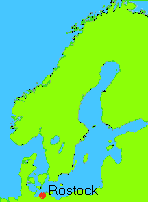Meet the Middle Ages
BackRostock

Rostock lies a little more than ten kilometres from the estuary of River Warnow. The town was founded on the river bank in the early 13th century. Soon, it was under the influence of Lübeck and in 1218 the laws of Lübeck were applied in Rostock as well. From 1314 and onwards, Rostock was ruled by the Duke of Mecklenburg. Rostock belonged to the Wendish Hanseatic League until 1630.
Rostock was an important port and commercial centre for the entire Baltic region. From there, beer and goods from far-off countries was exported. Spices were in great demand on the Nordic market, pepper, clove and saffron was very expensive. To use lots of spices in the food at feasts was a way of showing off one’s riches.
The Swedes, the Russians and the people from the Baltic countries, exported tar, stone, farm produce and timber to Rostock.
In the 16th century the town got a university, which was visited by many Swedish students.
In recent years, many old buildings in Rostock have been restored and they now give a good impression of what the town looked like in the 16th and 17th century.